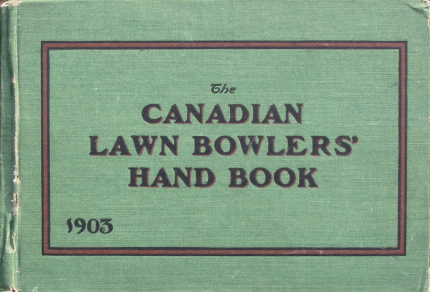| Title | The Canadian Lawn Bowlers' Handbook 1903 | ||
| Compilers | Believed to be those listed under 'Publishers' | ||
| Publishers | Geo R Hargraft, Q D McCulloch, A S Wigmore and David Carlyle | ||
| First published | 1903 | ||
| ISBN | Pre-ISBN system | ||
| Edition reviewed | 1st | ||
| Hardback/softback | Hardback | ||
| List price | Not known | ||
| Cover size (cm) (height x width) |
15.7 x 21.8 | ||
| Number of pages | 420 (including advertisements) | ||
| Number of pages with | Coloured photos | Black & white photos | Line drawings |
| None | 199 | 2 | |
| Synopsis | I've made the assumption in the details shown above that the compilers and publishers of this book were the same four gentlemen who appear in a photographic montage captioned 'Publishers Lawn Bowlers Handbook'. Whatever the truth, the 400-page book represents a major undertaking that has many similarities to a book that post-dated it by over 50 years, namely Godfrey Bolsover's 1300-page Who's Who and Encyclopaedia of Bowls published in 1959.
The bulk of The Canadian Lawn Bowlers' Handbook 1903 is devoted to detailed descriptions of Canadian bowling associations and clubs - chiefly those in Ontario. Typically, those sections dealing with associations have information on the constitution, by-laws, rules, history, records, and lists and photos of past and present officers. Information on the 72 clubs listed varies from an entry of one or two lines to three or four pages - the latter usually including the club's history, size of membership and list and photos of officers. The last part of the book contains a miscellany that includes contents entitled:
The large number of advertisements (158 pages) occur randomly throughout the book and, apart from the expected appearance of suppliers of bowls and accessories, range in subject matter from dental, legal and funeral services to merchants selling leather goods, fine furs, cigars, hardware, railway lamps and signals, stable requisites, and many more. Overall, this fascinating magnum opus is a bowls historian's delight - the likes of which may never be repeated. |
||



